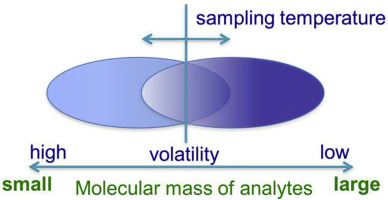当前位置:
X-MOL 学术
›
Anal. Chim. Acta
›
论文详情
Our official English website, www.x-mol.net, welcomes your
feedback! (Note: you will need to create a separate account there.)
Effect of temperature control on the metabolite content in exhaled breath condensate
Analytica Chimica Acta ( IF 5.7 ) Pub Date : 2018-05-01 , DOI: 10.1016/j.aca.2017.12.025 Konstantin O Zamuruyev 1 , Eva Borras 1 , Dayna R Pettit 1 , Alexander A Aksenov 1 , Jason D Simmons 1 , Bart C Weimer 2 , Michael Schivo 3 , Nicholas J Kenyon 3 , Jean-Pierre Delplanque 1 , Cristina E Davis 1
Analytica Chimica Acta ( IF 5.7 ) Pub Date : 2018-05-01 , DOI: 10.1016/j.aca.2017.12.025 Konstantin O Zamuruyev 1 , Eva Borras 1 , Dayna R Pettit 1 , Alexander A Aksenov 1 , Jason D Simmons 1 , Bart C Weimer 2 , Michael Schivo 3 , Nicholas J Kenyon 3 , Jean-Pierre Delplanque 1 , Cristina E Davis 1
Affiliation

|
The non-invasive, quick, and safe collection of exhaled breath condensate makes it a candidate as a diagnostic matrix in personalized health monitoring devices. The lack of standardization in collection methods and sample analysis is a persistent limitation preventing its practical use. The collection method and hardware design are recognized to significantly affect the metabolomic content of EBC samples, but this has not been systematically studied. Here, we completed a series of experiments to determine the sole effect of collection temperature on the metabolomic content of EBC. Temperature is a likely parameter that can be controlled to standardize among different devices. The study considered six temperature levels covering two physical phases of the sample; liquid and solid. The use of a single device in our study allowed keeping saliva filtering and collector surface effects as constant parameters and the temperature as a controlled variable; the physiological differences were minimized by averaging samples from a group of volunteers and a period of time. After EBC collection, we used an organic solvent rinse to collect the non-water-soluble compounds from the condenser surface. This additional matrix enhanced metabolites recovery, was less dependent on temperature changes, and may possibly serve as an additional pointer to standardize EBC sampling methodologies. The collected EBC samples were analyzed with a set of mass spectrometry methods to provide an overview of the compounds and their concentrations present at each temperature level. The total number of volatile and polar non-volatile compounds slightly increased in each physical phase as the collection temperature was lowered to minimum, 0 °C for liquid and -30, -56 °C for solid. The low-polarity non-volatile compounds showed a weak dependence on the collection temperature. The metabolomic content of EBC samples may not be solely dependent on temperature but may be influenced by other phenomena such as greater sample dilution due to condensation from the ambient air at colder temperatures, or due to adhesion properties of the collector surface and occurring chemical reactions. The relative importance of other design parameters such as condenser coating versus temperature requires further investigation.
中文翻译:

温度控制对呼出气冷凝物中代谢物含量的影响
呼出气冷凝物的非侵入性、快速和安全收集使其成为个性化健康监测设备中诊断矩阵的候选者。收集方法和样本分析缺乏标准化是阻碍其实际应用的长期限制。收集方法和硬件设计被认为会显着影响 EBC 样品的代谢组学含量,但这尚未得到系统研究。在这里,我们完成了一系列实验,以确定收集温度对 EBC 代谢组学含量的唯一影响。温度是可以控制以在不同设备之间标准化的可能参数。该研究考虑了涵盖样品两个物理阶段的六个温度水平;液体和固体。在我们的研究中使用单个设备允许将唾液过滤和收集器表面效应保持为恒定参数,并将温度作为受控变量;通过平均来自一组志愿者和一段时间的样本,生理差异被最小化。EBC 收集后,我们使用有机溶剂冲洗收集冷凝器表面的非水溶性化合物。这种额外的基质增强了代谢物的回收率,对温度变化的依赖性较小,并且可能作为标准化 EBC 采样方法的额外指标。使用一组质谱方法分析收集的 EBC 样品,以提供每个温度水平下存在的化合物及其浓度的概览。当收集温度降至最低时,每个物理相中挥发性和极性非挥发性化合物的总数略有增加,液体为 0 °C,固体为 -30、-56 °C。低极性非挥发性化合物对收集温度的依赖性较弱。EBC 样品的代谢组学含量可能不仅仅取决于温度,还可能受其他现象的影响,例如由于在较冷温度下环境空气冷凝导致样品稀释更大,或者由于收集器表面的粘附特性和发生的化学反应。其他设计参数(如冷凝器涂层与温度的关系)的相对重要性需要进一步研究。低极性非挥发性化合物对收集温度的依赖性较弱。EBC 样品的代谢组学含量可能不仅仅取决于温度,还可能受其他现象的影响,例如由于在较冷温度下环境空气冷凝导致样品稀释更大,或者由于收集器表面的粘附特性和发生的化学反应。其他设计参数(如冷凝器涂层与温度的关系)的相对重要性需要进一步研究。低极性非挥发性化合物对收集温度的依赖性较弱。EBC 样品的代谢组学含量可能不仅仅取决于温度,还可能受其他现象的影响,例如由于在较冷温度下环境空气冷凝导致样品稀释更大,或者由于收集器表面的粘附特性和发生的化学反应。其他设计参数(如冷凝器涂层与温度的关系)的相对重要性需要进一步研究。或由于集电器表面的粘附特性和发生的化学反应。其他设计参数(如冷凝器涂层与温度的关系)的相对重要性需要进一步研究。或由于集电器表面的粘附特性和发生的化学反应。其他设计参数(如冷凝器涂层与温度的关系)的相对重要性需要进一步研究。
更新日期:2018-05-01
中文翻译:

温度控制对呼出气冷凝物中代谢物含量的影响
呼出气冷凝物的非侵入性、快速和安全收集使其成为个性化健康监测设备中诊断矩阵的候选者。收集方法和样本分析缺乏标准化是阻碍其实际应用的长期限制。收集方法和硬件设计被认为会显着影响 EBC 样品的代谢组学含量,但这尚未得到系统研究。在这里,我们完成了一系列实验,以确定收集温度对 EBC 代谢组学含量的唯一影响。温度是可以控制以在不同设备之间标准化的可能参数。该研究考虑了涵盖样品两个物理阶段的六个温度水平;液体和固体。在我们的研究中使用单个设备允许将唾液过滤和收集器表面效应保持为恒定参数,并将温度作为受控变量;通过平均来自一组志愿者和一段时间的样本,生理差异被最小化。EBC 收集后,我们使用有机溶剂冲洗收集冷凝器表面的非水溶性化合物。这种额外的基质增强了代谢物的回收率,对温度变化的依赖性较小,并且可能作为标准化 EBC 采样方法的额外指标。使用一组质谱方法分析收集的 EBC 样品,以提供每个温度水平下存在的化合物及其浓度的概览。当收集温度降至最低时,每个物理相中挥发性和极性非挥发性化合物的总数略有增加,液体为 0 °C,固体为 -30、-56 °C。低极性非挥发性化合物对收集温度的依赖性较弱。EBC 样品的代谢组学含量可能不仅仅取决于温度,还可能受其他现象的影响,例如由于在较冷温度下环境空气冷凝导致样品稀释更大,或者由于收集器表面的粘附特性和发生的化学反应。其他设计参数(如冷凝器涂层与温度的关系)的相对重要性需要进一步研究。低极性非挥发性化合物对收集温度的依赖性较弱。EBC 样品的代谢组学含量可能不仅仅取决于温度,还可能受其他现象的影响,例如由于在较冷温度下环境空气冷凝导致样品稀释更大,或者由于收集器表面的粘附特性和发生的化学反应。其他设计参数(如冷凝器涂层与温度的关系)的相对重要性需要进一步研究。低极性非挥发性化合物对收集温度的依赖性较弱。EBC 样品的代谢组学含量可能不仅仅取决于温度,还可能受其他现象的影响,例如由于在较冷温度下环境空气冷凝导致样品稀释更大,或者由于收集器表面的粘附特性和发生的化学反应。其他设计参数(如冷凝器涂层与温度的关系)的相对重要性需要进一步研究。或由于集电器表面的粘附特性和发生的化学反应。其他设计参数(如冷凝器涂层与温度的关系)的相对重要性需要进一步研究。或由于集电器表面的粘附特性和发生的化学反应。其他设计参数(如冷凝器涂层与温度的关系)的相对重要性需要进一步研究。











































 京公网安备 11010802027423号
京公网安备 11010802027423号